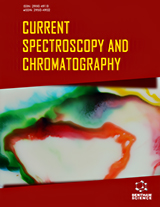Abstract
The electrochemical reduction of 4-{[(1E)-(2-hydroxynaphthyl)methylidene]amino}-1,5-dimethyl-2-phenyl- 2,3-dihydro-1H-pyrazol-3-one (NAP) was studied by using cyclic voltammetry in acetonitrile media at a glassy carbon (GC) and modified GC electrodes. The GC electrodes were grafted by electrochemical reduction of diazonium salts of various organic molecules. GC surfaces modified with anthraquinone, p-nitrophenyl, p-aminophenyl, p-amino-N,Ndimethylphenyl and p-methoxyphenyl radicals were used to investigate the reduction behaviors of NAP. The effect of the modified glassy carbon electrodes on the reduction of NAP was studied as being related to the role of the electron donor or the electron acceptor groups on the phenyl ring attached to the surface. The compound NAP shows two reduction peaks in a cyclic voltammogram. These peaks were observed at – 2.1 V and – 2.7 V on the GC electrode surface. Also, the reduction peaks of NAP were obtained for all the modified electrodes studied. The p-methoxyphenyl modified GC electrode showed a significant increase in the rate of electron transfer at the reduction of NAP. The kinetics and the mechanism of the electrode process were simulated and some parameters were calculated using BAS Digi-Sim® software.
Keywords: Schiff base, Cyclic voltammetry, Modified glassy carbon, Diazonium salt
Current Analytical Chemistry
Title: Electrochemical Reduction of NAP on the Glassy Carbon Electrodes Modified with Aromatic Diazonium Salts
Volume: 4 Issue: 2
Author(s): Murat Sadikoglu, Ali O. Solak, Muhammet Isiklan and Zeynel Kilic
Affiliation:
Keywords: Schiff base, Cyclic voltammetry, Modified glassy carbon, Diazonium salt
Abstract: The electrochemical reduction of 4-{[(1E)-(2-hydroxynaphthyl)methylidene]amino}-1,5-dimethyl-2-phenyl- 2,3-dihydro-1H-pyrazol-3-one (NAP) was studied by using cyclic voltammetry in acetonitrile media at a glassy carbon (GC) and modified GC electrodes. The GC electrodes were grafted by electrochemical reduction of diazonium salts of various organic molecules. GC surfaces modified with anthraquinone, p-nitrophenyl, p-aminophenyl, p-amino-N,Ndimethylphenyl and p-methoxyphenyl radicals were used to investigate the reduction behaviors of NAP. The effect of the modified glassy carbon electrodes on the reduction of NAP was studied as being related to the role of the electron donor or the electron acceptor groups on the phenyl ring attached to the surface. The compound NAP shows two reduction peaks in a cyclic voltammogram. These peaks were observed at – 2.1 V and – 2.7 V on the GC electrode surface. Also, the reduction peaks of NAP were obtained for all the modified electrodes studied. The p-methoxyphenyl modified GC electrode showed a significant increase in the rate of electron transfer at the reduction of NAP. The kinetics and the mechanism of the electrode process were simulated and some parameters were calculated using BAS Digi-Sim® software.
Export Options
About this article
Cite this article as:
Sadikoglu Murat, Solak O. Ali, Isiklan Muhammet and Kilic Zeynel, Electrochemical Reduction of NAP on the Glassy Carbon Electrodes Modified with Aromatic Diazonium Salts, Current Analytical Chemistry 2008; 4 (2) . https://dx.doi.org/10.2174/157341108784587803
| DOI https://dx.doi.org/10.2174/157341108784587803 |
Print ISSN 1573-4110 |
| Publisher Name Bentham Science Publisher |
Online ISSN 1875-6727 |
 2
2
- Author Guidelines
- Bentham Author Support Services (BASS)
- Graphical Abstracts
- Fabricating and Stating False Information
- Research Misconduct
- Post Publication Discussions and Corrections
- Publishing Ethics and Rectitude
- Increase Visibility of Your Article
- Archiving Policies
- Peer Review Workflow
- Order Your Article Before Print
- Promote Your Article
- Manuscript Transfer Facility
- Editorial Policies
- Allegations from Whistleblowers
- Announcements


























